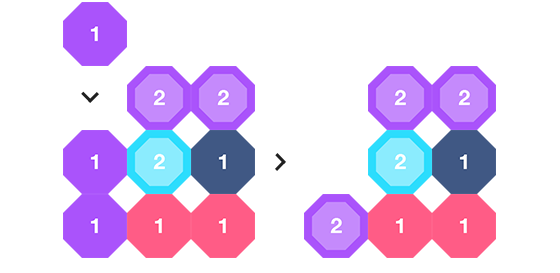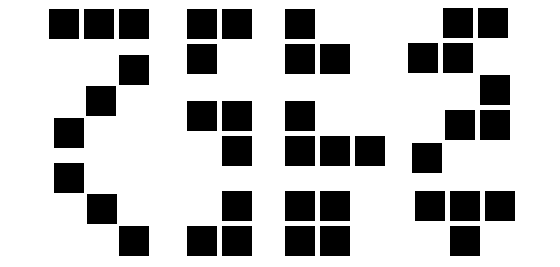Hi! I‘m
Arnold Rauers.
Since 2012 I create mobile games
with various talented people
as Tinytouchtales.

We've made GUNCHO, Geo Gods, Card Crawl Adventure, Gnomitaire, Maze Machina, Miracle Merchant, Card Thief, ENYO and Card Crawl which are available on the App Store and Google Play.
I publish Game Jam games and showcase my game ideas and prototypes on Itch.io.
If you would like to support me and my work consider becoming a Patron.
You can subscribe to my Newsletter, follow me on Twitter, Instagram or TikTok and join our Discord community.
2014-01-18 - Tinytouchtales
Weekly Update #2
Hi!
Welcome to the 2nd Weekly Update ever!
This week we would like to give some Design insides on the gameplay of Muffin Munch 2 and how it evolved from the Matchagon version to it’s own unique version.
Matchagon
For those who don’t know how the game design of Matchagon works, you should head over to www.matchagon.com and take a look at the gameplay video.
Matchagon evolves around the idea of stacking blocks inside a fixed grid, pretty much like Tetris. The difference is that you have unified shapes that only occupy one square in a 5×6 squares big grid. The goal is to remove as many blocks as possible (score points) from the grid, once the 5×6 squares are filled with blocks the game is over. Like in Tetris you can see 1 upcoming block to plan ahead.
There are 6 different colored blocks, which start at the value of 1, that can be combined in different ways. The first way is to stack up 3 or more of the same color vertically. Those 3 will combine into 1 block of the next higher value. Only blocks of the same value will match vertically. If you manage to stack up 3 blocks with the value 2, they combine into a “Joker” block (with a base value of 12) which can be matched with any other color. The handicap: Vertical stacking won’t give you any points.
To remove blocks from the gird and score points you have to either match 3 or more of the same color horizontally or diagonally. The value of the token relates to the amount of points you get for each removed block. If you manage to remove more than 1 group in a row each following match with be rewarded with 2x, 3x, 4x the points of the blocks value.

Matchagon was always designed to be a very relaxing experience where no time pressure is stressing you. Limited only by the space the gird is offering you, the game has a potential to be played endless. In a game that is designed to work on mobile phones, this is a little bit counter intuitive, as most of the game sessions shouldn’t last longer that 3-4 mins. We had reports of our best players who played 1:30h in one session, which is truly stunning but was never intended.
Improving a working system
Even though Matchagon is a pretty solid system that works, it also has its quirks. One thing we wanted to improve in Muffin Munch 2 is the fact that vertical Matches have a higher priority than others. This is particular anoying if you have a situation in which you exprect a horizontal or diagonal match, but the blocks get matched vertically instead.

Therefore we are changing the order in which matches are executed. The next thing we wanted to improve is the slow start. Sometimes it takes 1-2 mins before the first match happens and a lot of time is wasted by doing non meaningful moves. We try to address this problem with reducing the grid sizes from 5×6 to 4×4. Having less space means less decisions, but it also means those decisions become more meaningful, because you run out of space very fast if don’t think about your next block. To counter the difficulty of the smaller size, we introduce 2 new things:
A)
Only two Blocks aka Muffins are needed to form a vertical match. We also changed the way the values are handled. In Matchagon the way blocks where scored was 1+1+1=2, in Muffin Munch the Blocks are scored 1+1=2, 1+2=3, 2+1=3, 2+2=4. This means that the value of the Muffin is not important for a vertical match, where in Matchagon 1+2+1 didn’t worked in Muffin Munch you can combine any Muffin with a value lower than 3 or 4. When 2 Muffins with the value of 4 or 3 are combined they become the “Joker” which is matchable with any other color. With removing the explicit value > block type relation, we are no longer forced to show the value of the Muffin. Only the “Level” of the Muffin is important which is displayed by it’s 3 states.

B)
We introduce a third way of removing Muffins from the grid. It’s now possible to make horizontal, diagonal and corner matches to remove Muffins. This improves not only the possibilities to score points a lot, but also the chance to generate Chain-Matches is greatly improved. Additionally you have more options to combine those 3 types of matches, thus making the strategy of building up matches even more valuable.

The last thing we wanted to improve are the Blocker Blocks. In Matchagon we have a hard mode were every 10th Block is a black non matchable Block, blocking the gird. This introduces a new difficulty and makes the game a lot harder. Even though we like the idea of having a hard mode, the Blocker mechanic somewhat lacks it’s elegance and is a very simple and also not very clever way to introduce more difficulty. Blocker only serve one purpose and don’t improve the gameplay in any meaningful way.
After introducing the new corner match mechanic the gameplay of Muffin Munch was suddenly extremely random in terms of length. Some games, due to the randomness of the spawns, where again 10-15mins where others didn’t last longer than 1 min. So we had to come up with something that somehow balances the game in length. We took a look at the Blocker again.
As said the Blocker don’t serve any other purpose than blocking the grid and we did not like that a lot, but we came up with a pretty clever solution, which we basically stole from Drop7, one of the biggest influences on Matchagon. The simple but brilliant differences in Drop7 is that Blocker can be removed by matching Blocks next to them. In Drop7 the Blocker works in a way that they are normal Blocks, but “hidden” and unmatchable. After matching a group next to them they “break” and the second time a match happens next to them they reveal their value. This opens the possibility to play smartly so that you can remove Blocker from the grid and open up more space.
We simply used this approach and introduce removable Blocker in Muffin Munch. Those Blocker not only block the grid, but they hold the “Loot” in our game. To bake new Muffins you will find ingredients and recipes, which are stored inside the Blockers aka Boxes. If you manage to open a Box you have the chance to find a reward.
To balance the length of the game we have a very simple but elegant rule on when Boxes spawn. When a game starts you get a set of 14 Muffins in a row, the 15th beeing a Box, then a new set of Muffins is generated. How big the next set will be depens on the amount of Boxes removed/opened. This means that if are good you can open Boxes very fast, but the amount of Boxes that will spawn, will raise also very fast thus making the game harder and harder. In playtests we already managed to get to the “1 Muffin 1 Box” spawn mark, were the game definetally ends.

This new spawn rule created something that you could call emergent gameplay. Because now you can play the Game in two ways: 1) Open as much Boxes as possible or 2) score as many points as possible without opening Boxes, to keep the amount of spawning Muffins as high as possible.
We hope you liked this rather long post about the Game Design changes we made. We will talk about the Meta Game, baking new Muffins, very soon.